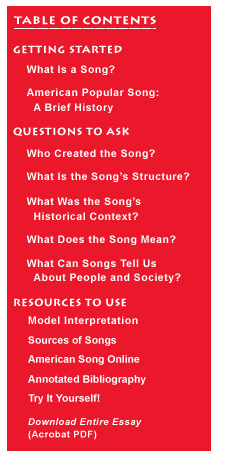talking history | syllabi | students | teachers | puzzle | about us

|
 |
|
It is commonplace to divide songs into different types, with three of the broadest categories being “classical,” “popular,” and “folk.” In practice these distinctions frequently break down. Is “Dixie” (1859) a “popular” or a “folk” song? We know its composer (Dan Emmett), and that it was created for the commercial theater. On the other hand, it is widely performed today in non-commercial contexts, and its transmission is primarily oral. For purposes of this guide, we will not distinguish between types of music. The techniques discussed will work equally well with most forms of American popular song. We talk about a “song” at least two different ways. The first is as a musical work, an abstract entity that serves as an umbrella for many versions or renditions. In most cases a song’s title marks it as being the “same” in all its various versions, although occasionally the same song acquires different titles and gains or loses lyrics. Second, we conceive of a song as a rendition, that is, a realization of the song in a performance, a publication, or a recording. Each rendition of a song is unique, although renditions may be very similar to one another. It is important to take a broad view of songs. They consist not just of the lyrics and the tune, but also of all the contexts in which a song is created, experienced, produced, and consumed. These contexts include such things as where the song was performed and by whom, the audience for it, and the technology that produced it and preserved it for us to appreciate. |
|

|
|
